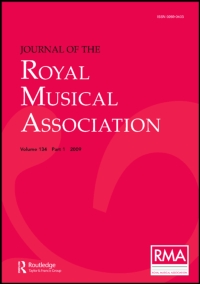Article contents
Town Waits and Their Tunes
Published online by Cambridge University Press: 01 January 2020
Extract
“The music of Waits—rude as may be their minstrelsy—breaks upon the mid-watches of the night with the effect of perfect harmony.” So writes Washington Irving, and though the experiences of those present will perhaps fail to endorse this description, we may, I think, spend an hour profitably in considering the origin, history, decay and disappearance of this old musical combination.
- Type
- Research Article
- Information
- Copyright
- Copyright © Royal Musical Association, 1927
References
1 Quoted by M. Arthur F. Hill in his article on “Waits” in the Handbook of the Worshipful Company of Musicians.Google Scholar
2 From the Liber Niger Domus Regis which contains an account of the household establishment of Edward IV.Google Scholar
3 Thieves.Google Scholar
4 Kirkpatrick.Google Scholar
5 Kirkpatrick.Google Scholar
6 N and Q III. 1. 337.Google Scholar
7 No. 222, September 9th, 1710. Probably written by Addison.Google Scholar
8 He was the son of a Wait.Google Scholar
9 Northumberland.Google Scholar
10 I am by no means satisfied that this derivation is correct, but no one has been able to explain the term in any other way.Google Scholar
11 N and Q. I. 3. 171.Google Scholar
12 It is obvious that the Canterbury Waits were not very efficient.Google Scholar
13 Burney says “I remember very well in my musical life and have heard one of the four waits of Shrewsbury vamp a bass on all occasions, being unable to read one that was written.” MS. quoted by Hill. This wait and Ravenscroft would have made a good pair.Google Scholar
14 Why a fat man cannot play well on a violin I have yet to discover!Google Scholar
15 It is only fair, however, to give the following from the Wakefield Cathedral Registers “The Waites of this town of Wakefield begane their Watch upon the 17th day of October in the year of our Lord God, 1670. Their names are as follows:—Google Scholar

It is hoped this fraternal spirit lasted!Google Scholar
16 See “The Drama,” etc., in Leicester by William Kelly. This resolved the discord!Google Scholar
17 Brent “Canterbury in the olden time.”Google Scholar
18 Chester during the Plantagenet and Tudor periods,” by the Rev. Canon Morris, p. 348.Google Scholar
19 A copy is in Cheetham's Library, Manchester. The words are given in “The Christmas Waits and Minstrels of bygone York” by T. P. Cooper.Google Scholar
20 Latimer's “Annals of Bristol 17th C.”Google Scholar
21 No one undertakes to pay Mr. Miller!Google Scholar
22 It is extraordinary to read of the proceedings of civic authorties at that period. They seem to have lost their heads entirely and Leicester is a typical instance. In 1836 that Corporation resolved that “the true dignity of the Mayoralty does not consist in antiquated pageantry,” and so they proceeded to sell five maces, the silver plate, the waits' collars and other reliques. They were no worse than many other towns however.Google Scholar
23 These are in a very rare form illustrating a curious legend regarding beavers which will be found in the Itinerary of Giraldus Cambrensis. Everyman Edn., p. 108.Google Scholar
24 Canon Galpin has met with the old form of “wayte-pipe.” “Pype” was gradually dropped and “wayt” only remained. No doubt this is the solution. He explained this at the meeting.Google Scholar
25 Owen and Blakeway, History of Shrewsbury.Google Scholar
26 N. and Q., v. 10, 494.Google Scholar
27 York Corporation Minutes, 3 Eliz. xxii.Google Scholar
28 The Antiquary, vol. 32, p. 191. Historical MSS. Committee 14th ReportGoogle Scholar
29 Ferdinando, the brother of Orlando Gibbons, was a Lincoln Wait, and no doubt often “cryed Christmas.” (Information kindly supplied by Dr. W. H. Grattan Flood).Google Scholar
30 See an article on “Waits” by F. A. Hadlam in Musical News, September, 1915.Google Scholar
31 It has been set to music by Dr. Stiver.Google Scholar
32 The Norfolk Chronicle, July 27th, 1907, article by J. C. Tingey.Google Scholar
32 Kemp's Nine Daies Wonder (1600), p. 17.Google Scholar
- 3
- Cited by


